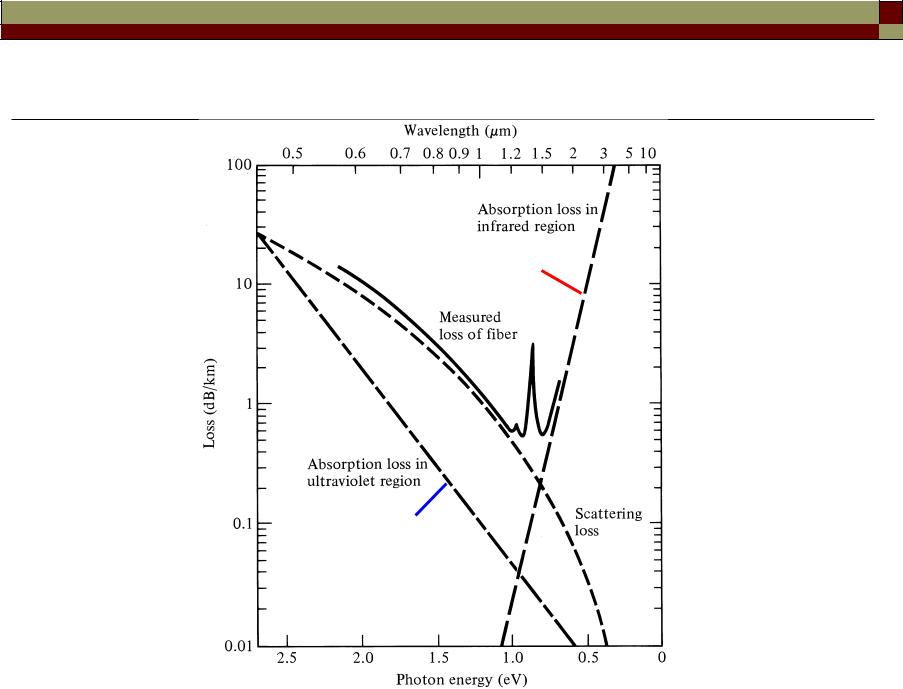
Lect5-Optical_fibers_2
.pdf
Attenuation in fibers
51

Transmission characteristics of optical fibers
• The transmission characteristics of most interest: attenuation (loss) and bandwidth.
• Now, silica-based glass fibers have losses less than 0.2 dB/km (i.e. 95 % launched power remains after 1 km of fiber transmission). This is essentially the fundamental lower limit for attenuation in silicabased glass fibers.
• Fiber bandwidth is limited by the signal dispersion within the fiber. Bandwidth determines the number of bits of information transmitted in a given time period. Now, fiber bandwidth has reached many 10’s Gbit over many km’s per wavelength channel.
52

Attenuation
• Signal attenuation within optical fibers is usually expressed in the logarithmic unit of the decibel.
The decibel, which is used for comparing two power levels, may be defined for a particular optical wavelength as the ratio of the output optical power Po from the fiber to the input optical power Pi.
Loss (dB) = - 10 log10 (Po/Pi) = 10 log10 (Pi/Po)
(Po ≤ Pi)
*In electronics, dB = 20 log10 (Vo/Vi)
53

Attenuation in dB/km
*The logarithmic unit has the advantage that the operations of multiplication (and division) reduce to addition (and subtraction).
In numerical values: |
Po/Pi = 10[-Loss(dB)/10] |
The attenuation is usually expressed in decibels per unit length (i.e. dB/km):
|
|
γ L = - 10 log10 (Po/Pi) |
γ (dB/km): signal attenuation per unit length in decibels
L (km): fiber length |
54 |

dBm
• dBm is a specific unit of power in decibels when the reference power is 1 mW:
dBm = 10 log10 (Power/1 mW)
e.g. 1 mW = 0 dBm; |
10 mW = 10 dBm; 100 W = - 10 dBm |
=> Loss (dB) = |
input power (dBm) - output power (dBm) |
e.g. Input power = 1 mW (0 dBm), output power = 100 W (-10 dBm) loss = -10 log10 (100 W/1 mW) = 10 dB
OR 0 dBm – (-10 dBm) = 10 dB
55

Fiber attenuation mechanisms
1. Material absorption
2. Scattering loss
3. Nonlinear loss
4.Bending loss
5.Mode coupling loss
• Material absorption is a loss mechanism related to both the material composition and the fabrication process for the fiber. The optical power is lost as heat in the fiber.
• The light absorption can be intrinsic (due to the material components of the glass) or extrinsic (due to impurities introduced into the glass during fabrication).
56

Intrinsic absorption
• Pure silica-based glass has two major intrinsic absorption mechanisms at optical wavelengths:
(1) a fundamental UV absorption edge, the peaks are centered in the ultraviolet wavelength region. This is due to the electron transitions within the glass molecules. The tail of this peak may extend into the the shorter wavelengths of the fiber transmission spectral window.
(2) A fundamental infrared and far-infrared absorption edge,
due to molecular vibrations (such as Si-O). The tail of these absorption peaks may extend into the longer wavelengths of the fiber transmission spectral window.
57

Fundamental fiber attenuation characteristics
IR absorption
UV absorption
(negligible in the IR)
58

Electronic and molecular absorption
Electronic absorption: the bandgap of fused silica is about 8.9 eV (~140 nm). This causes strong absorption of light in the UV spectral region due to electronic transitions across the bandgap.
In practice, the bandgap of a material is not sharply defined but usually has bandtails extending from the conduction and valence bands into the bandgap due to a variety of reasons, such as thermal vibrations of the lattice ions and microscopic imperfections of the material structure.
An amorphous material like fused silica generally has very |
|
long bandtails. These bandtails lead to an absorption tail |
|
extending into the visible and infrared regions. Empirically, |
|
the absorption tail at photon energies below the bandgap falls |
|
off exponentially with photon energy. |
59 |

Electronic and molecular absorption
Molecular absorption: in the infrared region, the absorption of photons is accompanied by transitions between different vibrational modes of silica molecules.
The fundamental vibrational transition of fused silica causes a very strong absorption peak at about 9 m wavelength.
Nonlinear effects contribute to important harmonics and combination frequencies corresponding to minor absorption peaks at 4.4, 3.8 and 3.2 m wavelengths.
=> a long absorption tail extending into the near infrared, causing a sharp rise in absorption at optical wavelengths longer than 1.6 m.
60
